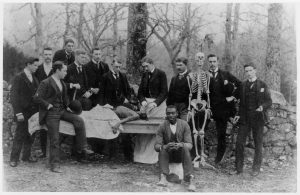The UNC School of Medicine opened in 1879 as a two-year preparatory program under the direction of Dr. Thomas West Harris. As dean of the fledgling school, he was not paid by the University but rather directly by students who took his classes. Dissection of human cadavers was considered an important part of the study of anatomy. The UNC course catalog of 1884 noted, “Dissection is made obligatory on students of anatomy. After the dissections are over, a short course on the operations of surgery is given. Students have the opportunity of making the operations for themselves.”

Dean of the UNC Medical School Dr. Richard Whitehead (center), medical students, and an assistant (front right) pose with a cadaver in the 1890s. From the University of North Carolina Image Collection, North Carolina Collection.
However, at this time it was difficult to procure cadavers for dissection, and medical schools were notorious for using bodies disinterred by graverobbers or “resurrectionists.” These men preyed on the graves of marginalized people – in the South, primarily African Americans. It is unclear how the University obtained cadavers in the earliest days of the Medical School, but students operated almost exclusively on on the bodies of African Americans, some of which may have been stolen.
At the time the Medical School was founded, there were no laws in North Carolina against graverobbing. In his history of the University, Kemp Plummer Battle, who was president during this period, recalled that one night, a woman who had worked as his father’s cook came to his house. She told him that a body had been stolen from a cemetery and a group was coming to search the University. Battle then confronted Dr. Harris, who only responded, “They will not find anything.” Battle reported that the body was not found and the culprits never identified, and professors assured the community that their students would not steal bodies. In 1885, the state made graverobbing a felony. According to Battle, this was in part due to local anxiety about dissection at the medical school.
After six years at UNC, Dr. Harris resigned to continue practicing medicine full-time in Durham and the Medical School closed. It reopened in 1890 under the leadership of Dean Richard Whitehead. In a letter Whitehead wrote to Professor Francis Venable shortly before beginning his tenure as dean, he emphasized the importance of dissection in his teaching.
Believing that only nature’s drawings are true, the instruction in [anatomy] will be eminently practical. The statements made will be proven by actual demonstration upon the cadaver, bones, and prepared specimens, and the student will be required to verify these statements for himself by dissecting and studying the dissected cadaver, as this is the only way in which a useful acquaintance with anatomy can be obtained.
According to Warner Lee Wells’ “Medical Education at Chapel Hill,” Whitehead was “vigorously opposed” to graverobbing and, once, when he learned a body had been disinterred, demanded that it be properly reburied. Whitehead instead purchased bodies, but they were often hard to obtain. Wells says that when cadavers were scarce, Whitehead would dissect one half of the body as a demonstration and then allow the students to dissect the other half.
In his 1891 annual report to the Board of Trustees, President Battle explained that new legislation might improve the situation:
If the bill now pending in the General Assembly which is like those of many other states, giving to this school the unclaimed bodies of convicts shall become law, there will be abundance of material for dissection. If not such material must be obtained as heretofore, at considerable expense, from a Western City.
It’s unclear which “Western City” Battle is referring to – the report Whitehead submitted to Battle the week before Battle presented to the Board says that cadavers were being bought from New York.
Soon after, a bill did pass granting medical schools in the state the unclaimed bodies of convicts. When the law was repealed in 1899, Whitehead lamented that the school’s “existence [was] in jeopardy . . . unless dissecting material can be obtained, it will be necessary to close the school.” He lobbied for a new bill, testifying before the House Judiciary Committee. On January 19, 1899, the News and Observer reported:
[Whitehead] said that there are two methods by which bodies can be obtained: One by systematic robbery of graves; and one is by law. He didn’t think the law ought to apply to any one except outcasts.
The proposed bill, he said, was a copy of the law in operation in a neighboring State. ‘I have been buying bodies in Northern States, but I can no longer do that. All the States now have laws forbidding the exportation of bodies, and no one can be found bold enough to undertake it. When I was able to get them they cost $40 apiece. Now I can’t get them at any price, and personally I’m not going into the grave robbing business.
So you will see some such law as this is absolutely necessary for the maintenance of the medical schools of the State. Anatomy cannot be taught properly without the dissection of human bodies. For my school about nine bodies a year are required. I do not know how many are required for the other two schools – Davidson and Shaw.’
Dr. Whitehead thought under this law the bodies would cost about $10 each.
In his statement to the Judiciary Committee, Whitehead also revealed that UNC’s medical school, like many others, especially in the South, relied almost exclusively on the bodies of black men and women. According to the News and Observer, Whitehead testified that “only one white person had ever been dissected in his school. That was a young white man, about 18, that died in the criminal insane department.”
